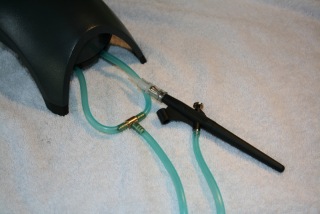 Finished seeder
There are many different vacuum seeders on the market. Some aimed at home gardeners and even more aimed at professional growers. Some of the major types include:
Finished seeder
There are many different vacuum seeders on the market. Some aimed at home gardeners and even more aimed at professional growers. Some of the major types include:
- Bulb type seeders which create a vacuum by squeezing a bulb and then releasing pressure when the vacuum tip is in the seeds
- Single tip vacuum seeder powered by a vacuum pump
- Multiple tip wands powered by a vacuum pump
- Plate seeders that have many holes that match the cells in planting flats. These too are powered by a vacuum pump.
The type we are going to cover in this project is a single tip vacuum seeder.
Material list.
- [Not a valid template] A Vacuum, in this case a Tetra 30-60 air pump for an aquarium, $19.99
- [Not a valid template] An air brush, $9.99
- [Not a valid template] Glue tips $2.00
- [Not a valid template]A small section of vinyl tubing with an inside diameter of 1/4 inch $0.25
- [Not a valid template] An air line tee $2.00
- [Not a valid template] A section of air line. In this case, more flexible is better.$2.00
Total cost for materials should be around. $36.00
Construction Details
- Modify the air brush
- Remove the paint needle. This is the gold portion at an angle with its tip in the tip of the air brush. It is a threaded fitting and will come out easily.
- [Not a valid template]The glue tips need to be pushed into the end of our vinyl tubing. The easiest method for us was to push it into the tip point first. We then could use the back of the air brush to press the tip into place.
- [Not a valid template]Once the tip is in place, you will need to press the tubing onto the air brush. This also requires a firm hand. In both cases, it is easiest if you leave the tubing longer than you need which gives you something to hold onto.
- [Not a valid template]Trim the excess of the tubing if you haven’t cut it to a one inch length earlier.
- Modify the pump
- [Not a valid template]The aquarium pump is meant to blow air, not suck, so we need to make a few modifications. First, remove the four screws from the bottom of the pump.
- [Not a valid template]Next we need to pull out the valves. These simply slide straight up. To get the white plastic part up where you can get a hold of it, you can pry in the very center with a sharp pointed tool. We used a normal kitchen knife. Just insert the tip of your tool at a steep angle between the bracket and valve. You will find a recess a small distance from the top that the tool can slip into to lever it up. You can grab the top edge of the valve with pliers once it moves a little to finish removing the valve from the housing.
- Repeat with second valve.
- [Not a valid template]You will need to twist the actual valve itself so that the large hole is next to the magnet. This is the opposite of what is shown in the photo.
- Reinstall both valves in housing by simply sliding them back into place.
- Reassemble the housing making note that there is a front and a back. It should easily slide together if it is being assembled in the right direction. Reinsert four screws removed earlier.
- Connect the air brush
- [Not a valid template]Cut two small sections of hose and connect to the two outputs on the air pump.
- Connect ends of tubing to air tee
- Connect remaining line to end of tee and air brush
Using the seeder
[Not a valid template]As soon as you plug in the pump it will start to run since it lacks a switch. You might want to consider attaching to a power strip for easy on and off operation. To use the vacuum seeder, you depress the button on the top of the air brush and dip its tip into your seeds. With the seed stuck to the tip, move the seeder over top of your desired planting location and release the button. Since the valve completely blocks any air intake, it is a good idea to turn off the seeder whenever you are not using it. Have fun.
I would love to hear from anyone who makes a version of the this vacuum seeder or would like to share ideas for other designs. If enough people are interested, I will make a multiple point seeder.


















Hi Glenn
Thanks for this, it’s the first DIY vacuum seeder I’ve seen on the net. Can I suggest that you include the keywords “DIY” and “needle seeder” in here because that is what I have been searching with. Or put this onto the Instructables website.
I work at Agresearch, a New Zealand government research organisation and our group studies and breeds white clover. I want to make a needle/ vacuum seeder like this to speed up sowing of larger trials so I’m looking at making multiple-tip seeders like this. I have a small vacuum pump that works well with single seeds using a plastic disposable pipette tip as the tip (using what is at hand). Last week I made a manifold that puts 96 of these tips together in a 8X12 grid (the same spacing as a 96 well microplate that we might use to store seeds and grow seedlings) but the vacuum pump is not strong enough to pick up seeds with this (only works if I let the vacuum build up and then I only have a few seconds of suction and it holds more than one seed on some of the tips). I’ll have to check for leaks or use a bigger vacuum pump. I’m planning to make some that are just a row of tips for seeding trays, something like this: http://www.gro-morent.com/wandseeder.htm One idea is to use garden watering/ sprinkler system components (those black tubing ones which you can screw risers into) to make this and attach it to my current vacuum pump.
It would be useful to have a flexible seed wand that can bend the tips together into one spot to pick up the seeds from a packet and then bend out to spread them out to sow the seeds into trays. I’m still thinking about that one!
Anyway, thanks for putting this up
Benjamin
I appreciate your comments.
I too have looked multiple times at the grow-mor seed wands. Incredibly expensive for what amounts to pvc with tubes attached. Since I am a home gardener, I have been looking at smaller tools because I often plant several varieties of seed in a single cell flat.
Elliot Coleman has referenced plans for a vacuum seeder in one of his books, I believe The Organic Grower but I have been unable to locate it. He also suggests that he has tried pumps for inflating rafts or inflatable beds. My experience has been that they are very loud, but maybe one of the manual ones would provide enough vacuum.
I also have thought about your last comments. My idea is to run the lines/tips through a flexible membrane. I might need to illustrate this but I’ll try to explain through words. Picture a handle with a flexible square of material , maybe rubber at the end of the handle. The handle could house the main vacuum line. The lines could then split into multiple lines attaching to needles that run through the flexible membrane. By attaching a mechanism to the center of the membrance, you could raise the center which in turn would pull the points toward the center. Then by pushing the membrance down, the tips would flex out.
If this doesn’t make sense, I will try to make a prototype.
Have a great growing season.